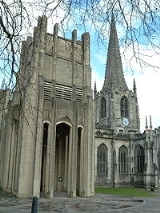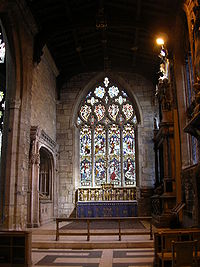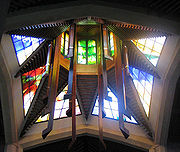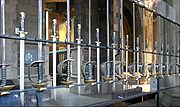
Sheffield Cathedral
Encyclopedia
Sheffield Cathedral is the cathedral
church for the Church of England
diocese
of Sheffield
, England
. Originally a parish church, it was elevated to cathedral status when the diocese was created in 1914. Sheffield Cathedral is one of five Grade I listed buildings in the city, along with Town Hall
, Abbeydale Industrial Hamlet
, and the parish churches at Ecclesfield
and Bradfield. It is located in the city centre
on Church Street
and served by Sheffield Supertram
's Cathedral stop.
 The site of the cathedral has a long history of Christian use. The shaft of the 9th century Sheffield Cross
The site of the cathedral has a long history of Christian use. The shaft of the 9th century Sheffield Cross
, believed to have formerly been sited here, is now held by the British Museum
. It is probable that Sheffield's parish church
, a satellite of Worksop Priory
, was constructed here in the twelfth century by William de Lovetot
at the opposite end of the town to Sheffield Castle
. This established the area of the parish
of Sheffield, unchanged until the 19th century. This church was burnt down in 1266 during the Second Barons' War
against King Henry III
.
Another parish church was completed in 1280, but this church was mostly demolished and rebuilt about 1430 on a cruciform
floor plan. The Shrewsbury Chapel was added in the next century, and a vestry
chapel (now the Chapel of Saint Katherine) was added in 1777. The north and south walls of the nave were rebuilt in 1790–3 and a major restoration
by Flockton & Gibbs—which included the addition of new north and south transepts was completed in 1880. The church was originally dedicated to Saint Peter
, but from some time after the reformation
into the 19th century it was dedicated to Holy Trinity, it has since been dedicated to both Saint Peter and Saint Paul
.
The parish of Sheffield was subdivided into smaller parishes in 1848. The church is still the parish church for the smaller Parish of Sheffield, but in 1914 it was also made the cathedral church for the newly-created Diocese of Sheffield. Plans were drafted by Charles Nicholson
to extend the church and reorient it on its axis, but due to World War II
these were greatly scaled down. The resulting additions leave the church an awkward shape in plan, but with an impressive south elevation.

 The East end of the current church is the oldest. In the east wall of the sanctuary there are stones from the 13th century church. Dating from the 15th century are the sanctuary and chancel. The 15th century cruciform church also included lofts and a rood chapel but were ordered removed by Queen Elizabeth. Their scars can be seen on the walls.
The East end of the current church is the oldest. In the east wall of the sanctuary there are stones from the 13th century church. Dating from the 15th century are the sanctuary and chancel. The 15th century cruciform church also included lofts and a rood chapel but were ordered removed by Queen Elizabeth. Their scars can be seen on the walls.
The chancel roof likely dates to the 16th century and is a hammer beam roof with gilded angels. The outstretched wings are a modern gift from the 1960s by George Bailey.
In the 1770s, rebuilding added tracery into the windows and a resurfacing of the walls with moorstone. The addition of the vestry chapel of St. Katherine destroyed the cruciform shape of the plan. The Shrewsbury Chapel was constructed in order to house the Tudor monuments of the Earls of Shrewsbury
. The altarpiece in this chapel is considered medieval in date. On the S wall of the Shrewbury Chapel is the alabaster monument to the Sixth
Earl of Shrewsbury with its architectural surround, armored effigy, and Latin inscription. Multiple members of the family are buried in the vault. The monument on the left towards the sanctuary is to Fourth
Earl of Shrewsbury. It is made of fine marble, carved in an Italian style to depict the Earl and his two wives in positions of prayer. They are both fine examples of Tudor monuments. The east window is a monument to James Montgomery
.
In the 1880s further reconstruction and rebuilding removed the galleries, moved the organ to the North transept to clear the chancel, and the pews were changed to the current oak pews. The North and South transepts and West end were extended. A screen was constructed by local craftsmen for the Shrewsbury Chapel but was modified and moved to the North aisle in the 1900s.
In the 1900s, Sir Charles Nicholson's design in the 1900s called for a radical realignment of the church axis by 90 degrees. However, funds and World Wars forced the designs to change. Those changes were implemented throughout the 20th century. The bulk of the changes have affected the Northern part of the cathedral which was extensively expanded. Immediately to the north of the nave is the chapel of Saint George that commemorates the York and Lancaster Regiment
. It is furnished with regiment flags and a screen made up of the bayonets and swords of the first regiment. Under the chapel of St. George is the vaulted crypt chapel of All Saints and the Te Deum window, which was designed by Christopher Webb
. At the furthest North end is the Chapel of the Holy Spirit with a four part vaulting system and a beautifully painted screen. The main entrance of the church is at the expanded west end, added in 1966 when the church was rededicated. The baptism font is at this end. The Lantern tower was an earlier addition to improve light but its glass was replaced by an abstract design designed by Amber Hiscott in 1998-99. In September 2010 it was announced that the cathedral would be applying for a £980,000 Heritage Lottery Fund
grant to fund a £1.25 million scheme to make the building more attractive to visitors.
was decommissioned in 1998 with a view to a long term replacement with another pipe organ. In the interim, a digital organ by Phoenix Organs is being used. In 2008 negotiations were undertaken with Warrington
Borough Council to purchase their Cavaillé-Coll organ from the Parr Hall
.
The organists are also responsible for direction of the Cathedral Choir.
, including a flat sixth bell.
The bells are rung regularly for practice on a Thursday and for Sunday services, both in the morning and the evening.
Cathedral
A cathedral is a Christian church that contains the seat of a bishop...
church for the Church of England
Church of England
The Church of England is the officially established Christian church in England and the Mother Church of the worldwide Anglican Communion. The church considers itself within the tradition of Western Christianity and dates its formal establishment principally to the mission to England by St...
diocese
Diocese of Sheffield
The Diocese of Sheffield is an administrative division of the Church of England, part of the Province of York.The Diocese of Sheffield was formed on January 23, 1914, by the division from the Diocese of York...
of Sheffield
Sheffield
Sheffield is a city and metropolitan borough of South Yorkshire, England. Its name derives from the River Sheaf, which runs through the city. Historically a part of the West Riding of Yorkshire, and with some of its southern suburbs annexed from Derbyshire, the city has grown from its largely...
, England
England
England is a country that is part of the United Kingdom. It shares land borders with Scotland to the north and Wales to the west; the Irish Sea is to the north west, the Celtic Sea to the south west, with the North Sea to the east and the English Channel to the south separating it from continental...
. Originally a parish church, it was elevated to cathedral status when the diocese was created in 1914. Sheffield Cathedral is one of five Grade I listed buildings in the city, along with Town Hall
Sheffield Town Hall
Sheffield Town Hall is a building in the City of Sheffield, England. The building is used by Sheffield City Council, and also contains a publicly displayed collection of silverware. The current building, Sheffield's fourth town hall, is located on Pinstone Street. It was designed by the...
, Abbeydale Industrial Hamlet
Abbeydale Industrial Hamlet
Abbeydale Industrial Hamlet is an industrial museum in the south of the City of Sheffield, England. The museum forms part of a former steel-working site on the River Sheaf, with a history going back to at least the 13th century...
, and the parish churches at Ecclesfield
Church of St. Mary, Ecclesfield
The Church of St. Mary, Ecclesfield is situated on Church Street in the village of Ecclesfield, now a northern suburb of Sheffield, South Yorkshire, England. It is situated seven kilometres north of the city centre. It is a Grade One listed building, one of only five within the Sheffield city...
and Bradfield. It is located in the city centre
Sheffield City Centre
Sheffield City Centre—often just referred to as town—is a district of the City of Sheffield, and part of the Sheffield Central ward. It includes the area that is within a radius of roughly of Sheffield Cathedral, and is encircled by the Inner Ring Road—a circular route started in the late 1960s...
on Church Street
Church Street (Sheffield)
Church Street is situated in the centre of Sheffield at the grid reference of . It runs for approximately 450 metres in a westerly direction from its junction with Fargate and High Street to its termination at the crossroads formed by the junction with West Street, Leopold Street and Townhead...
and served by Sheffield Supertram
Sheffield Supertram
The Supertram, officially called the Stagecoach Supertram, is a light rail tram system in the City of Sheffield, South Yorkshire, England...
's Cathedral stop.
History

Sheffield Cross
The Sheffield Cross is an Anglo-Saxon Christian monument, dating from the early ninth century. It is the shaft of a stone cross that was rediscovered hollowed out and in use as a quenching trough in a cutler's workshop in the Park district of Sheffield. It is now in the British Museum...
, believed to have formerly been sited here, is now held by the British Museum
British Museum
The British Museum is a museum of human history and culture in London. Its collections, which number more than seven million objects, are amongst the largest and most comprehensive in the world and originate from all continents, illustrating and documenting the story of human culture from its...
. It is probable that Sheffield's parish church
Parish church
A parish church , in Christianity, is the church which acts as the religious centre of a parish, the basic administrative unit of episcopal churches....
, a satellite of Worksop Priory
Worksop Priory
Worksop Priory is a Church of England parish church and former priory in the town of Worksop, Nottinghamshire, part of the Diocese of Southwell and Nottingham....
, was constructed here in the twelfth century by William de Lovetot
William de Lovetot
William de Lovetot, Lord of Hallamshire, possibly descended from the Norman Baron Ricardus Surdus, was an Anglo-Norman Baron from Huntingdonshire, often credited as the founder of Sheffield, England....
at the opposite end of the town to Sheffield Castle
Sheffield Castle
Sheffield Castle was a castle in Sheffield, England, constructed at the confluence of the River Sheaf and the River Don, possibly on the site of a former Anglo-Saxon long house, and dominating the early town. A motte and bailey castle had been constructed on the site at some time in the century...
. This established the area of the parish
Parish
A parish is a territorial unit historically under the pastoral care and clerical jurisdiction of one parish priest, who might be assisted in his pastoral duties by a curate or curates - also priests but not the parish priest - from a more or less central parish church with its associated organization...
of Sheffield, unchanged until the 19th century. This church was burnt down in 1266 during the Second Barons' War
Second Barons' War
The Second Barons' War was a civil war in England between the forces of a number of barons led by Simon de Montfort, against the Royalist forces led by Prince Edward , in the name of Henry III.-Causes:...
against King Henry III
Henry III of England
Henry III was the son and successor of John as King of England, reigning for 56 years from 1216 until his death. His contemporaries knew him as Henry of Winchester. He was the first child king in England since the reign of Æthelred the Unready...
.
Another parish church was completed in 1280, but this church was mostly demolished and rebuilt about 1430 on a cruciform
Cruciform
Cruciform means having the shape of a cross or Christian cross.- Cruciform architectural plan :This is a common description of Christian churches. In Early Christian, Byzantine and other Eastern Orthodox forms of church architecture this is more likely to mean a tetraconch plan, a Greek cross,...
floor plan. The Shrewsbury Chapel was added in the next century, and a vestry
Vestry
A vestry is a room in or attached to a church or synagogue in which the vestments, vessels, records, etc., are kept , and in which the clergy and choir robe or don their vestments for divine service....
chapel (now the Chapel of Saint Katherine) was added in 1777. The north and south walls of the nave were rebuilt in 1790–3 and a major restoration
Victorian restoration
Victorian restoration is the term commonly used to refer to the widespread and extensive refurbishment and rebuilding of Church of England churches and cathedrals that took place in England and Wales during the 19th-century reign of Queen Victoria...
by Flockton & Gibbs—which included the addition of new north and south transepts was completed in 1880. The church was originally dedicated to Saint Peter
Saint Peter
Saint Peter or Simon Peter was an early Christian leader, who is featured prominently in the New Testament Gospels and the Acts of the Apostles. The son of John or of Jonah and from the village of Bethsaida in the province of Galilee, his brother Andrew was also an apostle...
, but from some time after the reformation
English Reformation
The English Reformation was the series of events in 16th-century England by which the Church of England broke away from the authority of the Pope and the Roman Catholic Church....
into the 19th century it was dedicated to Holy Trinity, it has since been dedicated to both Saint Peter and Saint Paul
Paul of Tarsus
Paul the Apostle , also known as Saul of Tarsus, is described in the Christian New Testament as one of the most influential early Christian missionaries, with the writings ascribed to him by the church forming a considerable portion of the New Testament...
.
The parish of Sheffield was subdivided into smaller parishes in 1848. The church is still the parish church for the smaller Parish of Sheffield, but in 1914 it was also made the cathedral church for the newly-created Diocese of Sheffield. Plans were drafted by Charles Nicholson
Sir Charles Nicholson, 2nd Baronet
Sir Charles Archibald Nicholson, 2nd Baronet , became well-known as an ecclesiastical architect. He was the son of Sir Charles Nicholson, 1st Baronet, and brother of the stained glass artist Archibald Keightley Nicholson and of Sir Sydney Hugo Nicholson, organist at Westminster Abbey and founder of...
to extend the church and reorient it on its axis, but due to World War II
World War II
World War II, or the Second World War , was a global conflict lasting from 1939 to 1945, involving most of the world's nations—including all of the great powers—eventually forming two opposing military alliances: the Allies and the Axis...
these were greatly scaled down. The resulting additions leave the church an awkward shape in plan, but with an impressive south elevation.
Art and architecture


The chancel roof likely dates to the 16th century and is a hammer beam roof with gilded angels. The outstretched wings are a modern gift from the 1960s by George Bailey.
In the 1770s, rebuilding added tracery into the windows and a resurfacing of the walls with moorstone. The addition of the vestry chapel of St. Katherine destroyed the cruciform shape of the plan. The Shrewsbury Chapel was constructed in order to house the Tudor monuments of the Earls of Shrewsbury
Earl of Shrewsbury
Earl of Shrewsbury is a hereditary title of nobility created twice in the peerage of England.-First creation, 1074:The first creation occurred in 1074 for Roger de Montgomerie, one of William the Conqueror's principal counselors...
. The altarpiece in this chapel is considered medieval in date. On the S wall of the Shrewbury Chapel is the alabaster monument to the Sixth
George Talbot, 6th Earl of Shrewsbury
George Talbot, 6th Earl of Shrewsbury, 6th Earl of Waterford, 12th Baron Talbot, KG, Earl Marshal was a 16th century English statesman.-Life:...
Earl of Shrewsbury with its architectural surround, armored effigy, and Latin inscription. Multiple members of the family are buried in the vault. The monument on the left towards the sanctuary is to Fourth
George Talbot, 4th Earl of Shrewsbury
George Talbot, 4th Earl of Shrewsbury, 4th Earl of Waterford, 10th Baron Talbot, 9th Baron Furnivall, KG was the son of John Talbot, 3rd Earl of Shrewsbury and Lady Catherine Stafford, daughter of the 1st Duke of Buckingham....
Earl of Shrewsbury. It is made of fine marble, carved in an Italian style to depict the Earl and his two wives in positions of prayer. They are both fine examples of Tudor monuments. The east window is a monument to James Montgomery
James Montgomery
James Montgomery was a British editor, hymnwriter and poet. He was particularly associated with humanitarian causes such as the campaigns to abolish slavery and to end the exploitation of child chimney sweeps....
.
In the 1880s further reconstruction and rebuilding removed the galleries, moved the organ to the North transept to clear the chancel, and the pews were changed to the current oak pews. The North and South transepts and West end were extended. A screen was constructed by local craftsmen for the Shrewsbury Chapel but was modified and moved to the North aisle in the 1900s.
In the 1900s, Sir Charles Nicholson's design in the 1900s called for a radical realignment of the church axis by 90 degrees. However, funds and World Wars forced the designs to change. Those changes were implemented throughout the 20th century. The bulk of the changes have affected the Northern part of the cathedral which was extensively expanded. Immediately to the north of the nave is the chapel of Saint George that commemorates the York and Lancaster Regiment
York and Lancaster Regiment
-History:It was formed in 1881 through the amalgamation of two other regiments:*65th Regiment*84th RegimentThe title of the regiment was derived not from the cities of York and Lancaster, or from the counties...
. It is furnished with regiment flags and a screen made up of the bayonets and swords of the first regiment. Under the chapel of St. George is the vaulted crypt chapel of All Saints and the Te Deum window, which was designed by Christopher Webb
Christopher Webb
Christopher Rahere Webb was an English stained glass designer. His unusual second name was derived from that of the founder of St Bartholomew’s Priory in London where his father, Sir Aston Webb carried out some important restoration work. Webb was educated at Rugby School and at the Slade School...
. At the furthest North end is the Chapel of the Holy Spirit with a four part vaulting system and a beautifully painted screen. The main entrance of the church is at the expanded west end, added in 1966 when the church was rededicated. The baptism font is at this end. The Lantern tower was an earlier addition to improve light but its glass was replaced by an abstract design designed by Amber Hiscott in 1998-99. In September 2010 it was announced that the cathedral would be applying for a £980,000 Heritage Lottery Fund
Heritage Lottery Fund
The Heritage Lottery Fund is a fund established in the United Kingdom under the National Lottery etc. Act 1993. The Fund opened for applications in 1994. It uses money raised through the National Lottery to transform and sustain the UK’s heritage...
grant to fund a £1.25 million scheme to make the building more attractive to visitors.
Organ
The pipe organ by N. P. Mander Ltd.Mander Organs
Mander Organs is an English pipe organ maker and refurbisher based in London. Although well known for many years in the world of organ building, they achieved wider notability in 2004 with their refurbishment of the Royal Albert Hall's Father Willis organ....
was decommissioned in 1998 with a view to a long term replacement with another pipe organ. In the interim, a digital organ by Phoenix Organs is being used. In 2008 negotiations were undertaken with Warrington
Warrington
Warrington is a town, borough and unitary authority area of Cheshire, England. It stands on the banks of the River Mersey, which is tidal to the west of the weir at Howley. It lies 16 miles east of Liverpool, 19 miles west of Manchester and 8 miles south of St Helens...
Borough Council to purchase their Cavaillé-Coll organ from the Parr Hall
Parr Hall
The Parr Hall is the only surviving professional concert hall/theatre venue in Warrington, England.-Location:The Parr Hall and Pyramid Arts Centre are located in the Cultural quarter of Warrington town centre, in Palmyra Square.-History:...
.
Organists
- 1892 Thomas William Hanforth
- 1937 Reginald Tustin Baker
- 1966 Graham Matthews
- 1991 Paul BroughPaul BroughPaul Brough is an English conductor, and a teacher of conducting. He began 2011 as the new Principal Guest Conductor of the BBC Singers....
- 1994 Simon LoleSimon LoleSimon Lole is well known as a choral director, organist, composer, arranger and broadcaster. He was organist of Barking Parish Church , Croydon Parish Church , Director of Music at St...
- 1997 Neil Taylor
The organists are also responsible for direction of the Cathedral Choir.
Change ringing
The cathedral has 13 bells hung for change ringingChange ringing
Change ringing is the art of ringing a set of tuned bells in a series of mathematical patterns called "changes". It differs from many other forms of campanology in that no attempt is made to produce a conventional melody....
, including a flat sixth bell.
The bells are rung regularly for practice on a Thursday and for Sunday services, both in the morning and the evening.
See also
- Cathedral Church of St. Marie, Sheffield
- History of SheffieldHistory of SheffieldThe history of Sheffield, a city in South Yorkshire, England, can be traced back to the founding of a settlement in a clearing beside the River Sheaf in the second half of the 1st millennium AD...
- Listed buildings in Sheffield

